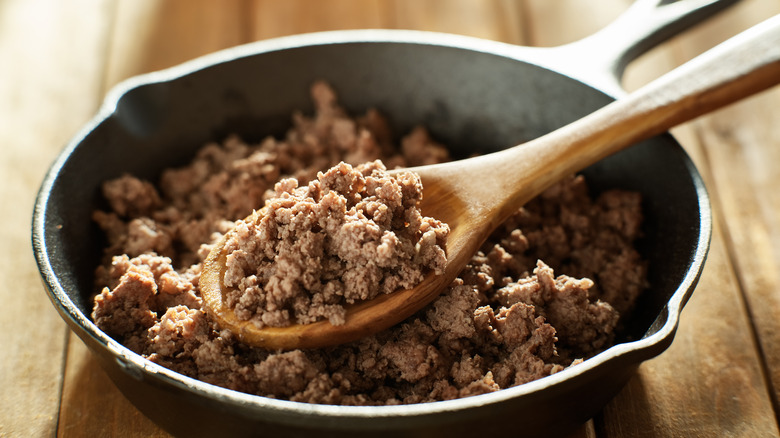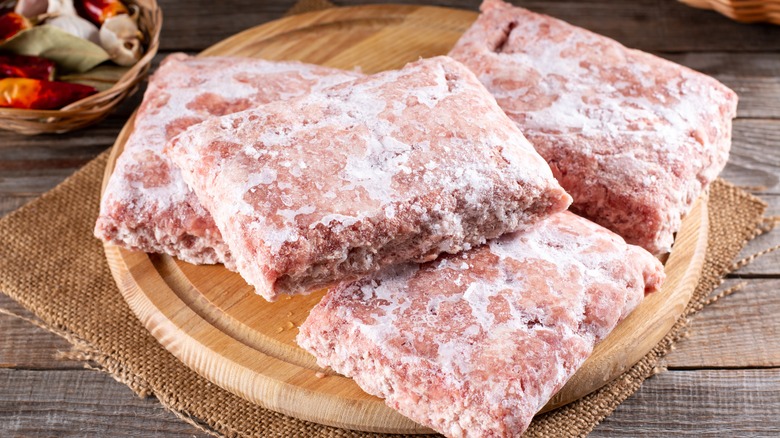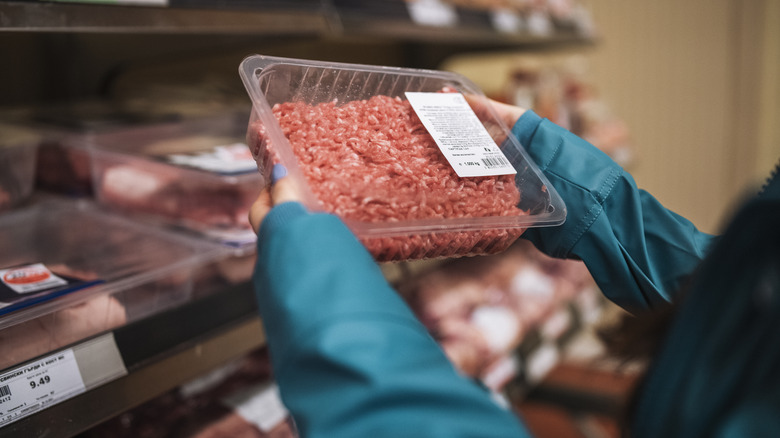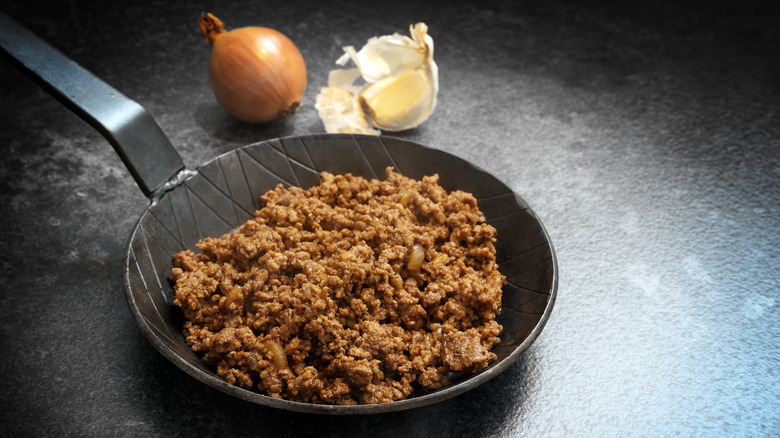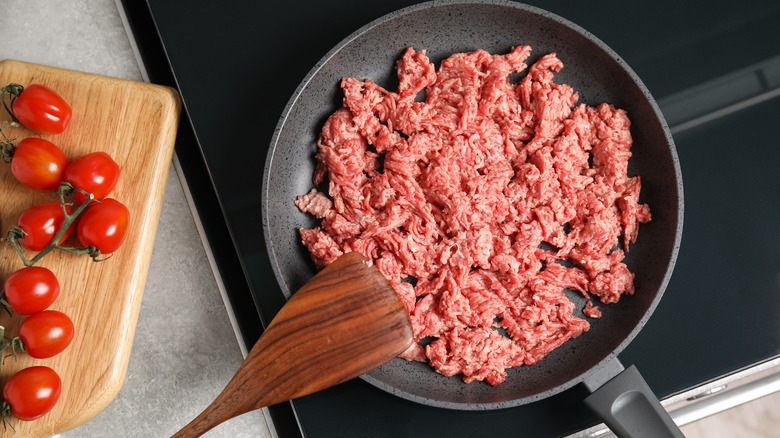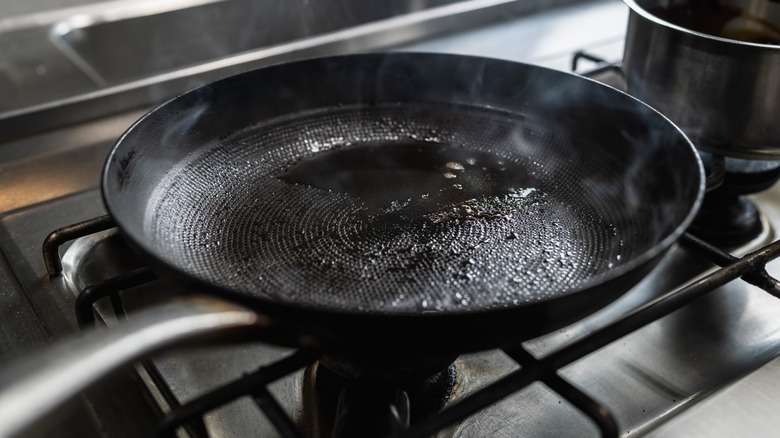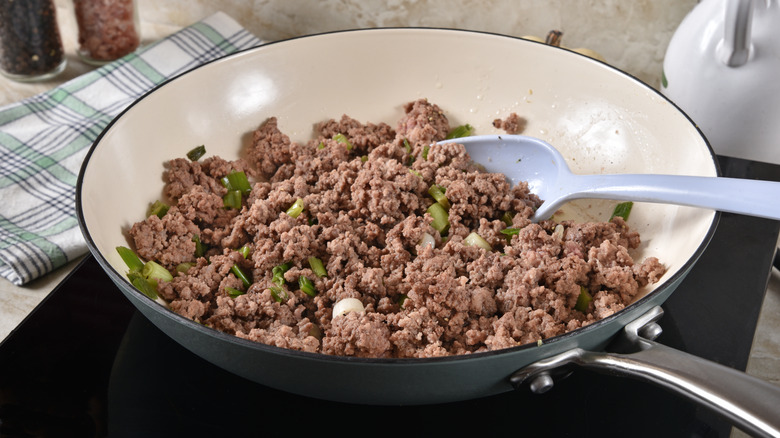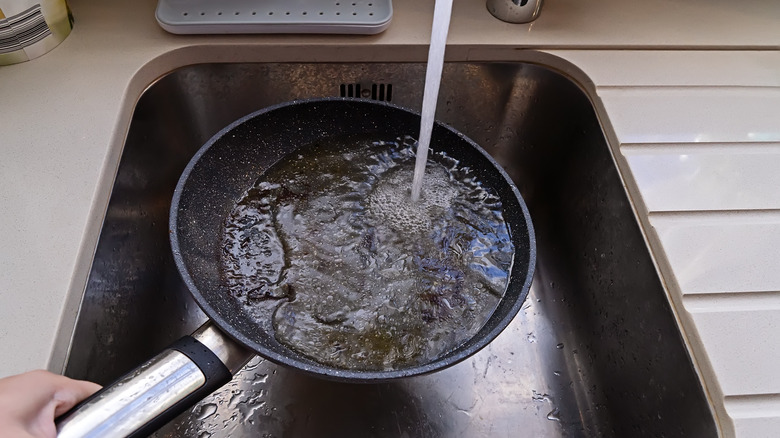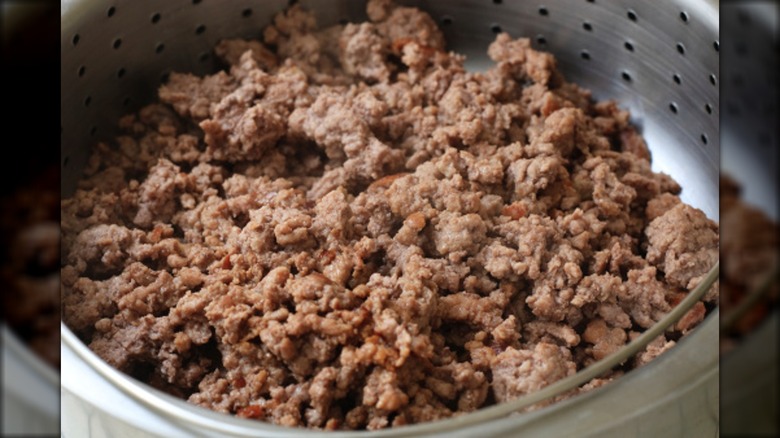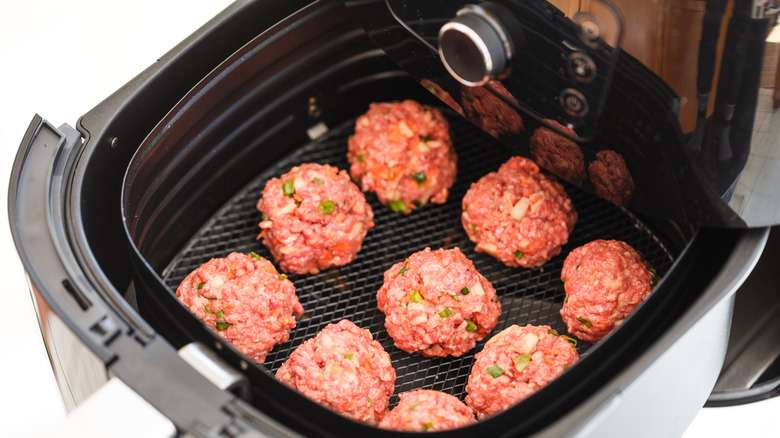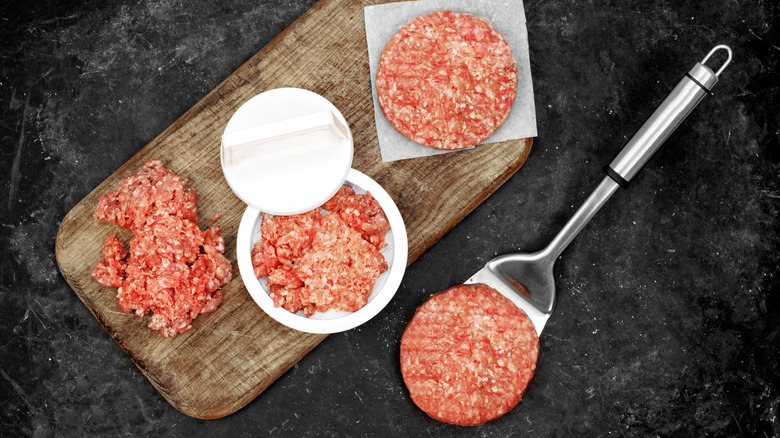10 Mistakes Everyone Makes When Cooking Ground Beef
Ground beef is a crucial ingredient in many recipes, including tacos, hamburgers, spaghetti sauce, and shepherd's pie. Chances are pretty high that you've cooked ground beef once, twice, or even several times. You might see it as one of the easier types of meat to cook — much easier than something like steak tartare. However, you may be surprised to learn that despite its prominence in a variety of recipes across the board, from simple to gourmet, many people make mistakes when cooking ground beef.
Learning how to properly cook ground beef can ensure that it doesn't turn out dry or lacking in flavor. Avoiding the following common mistakes will simplify your job in the kitchen, protect you and those you're serving from foodborne illnesses, and even prevent inadvertent damage to your kitchen appliances. Read on to learn what not to do and what you should do instead when cooking ground beef.
Thawing ground beef on the kitchen counter
Tonight you're planning to add ground beef to your stuffed pepper mix. So, you pull out a few pounds from the freezer, put them on the counter to thaw, and return a few hours later to put them in the fridge. But, this is a mistake.
You should never thaw ground beef — or any other meats, for that matter — on the kitchen counter. The USDA says that doing so is not safe and can increase the risk of foodborne illnesses. The reason for this has to do with something called the danger zone, or the temperature range between 40 and 140 degrees Fahrenheit where bacteria can quickly multiply. When you leave meat on the counter, the outer portions thaw more quickly than the frozen center meaning they could fall into the danger zone while the center is still defrosting.
Instead of thawing ground beef on the counter, try to remove it from the freezer about 24 hours before you want to cook it. This way it can safely thaw in the refrigerator overnight. If you need to thaw the beef more quickly, put it in a leak-proof plastic bag and thaw it in cold tap water. Replace the water approximately every 30 minutes to make sure it doesn't get too warm, and move the meat to the fridge once thawed.
Not choosing ground beef with the right fat content
There are different fat content options for ground beef indicating the ratio of lean meat to fat. Each is made from different parts of the cow and may be better suited for different recipe types.
Packages labeled 70/30 or "ground beef" have a ratio of 70% lean meat to 30% fat. They are sourced from leftover trimmings from the cow. This meat may end up on the greasier side and will also shrink more as it cooks and the fat melts down. These cuts could be a good fit for those looking to make a juicy burger.
Ground beef with an 80% lean to 20% fat ratio is called ground chuck. Sourced from the neck and shoulders of the cow, it still has a fair amount of fat, making it ideal for flavorful burgers, meatballs, and other endeavors.
Ground round comes from the hind legs, knees, hips, and rump region and offers a slightly lower fat content, with an 85% lean meat to 15% fat ratio. Because it can dry out more, you might only want to choose it for sauces or other recipes where you'll be adding more flavors or seasonings to the beef.
Ground sirloin with a 90% lean meat to 10% fat ratio, can be an option for those looking to limit fat. However, it dries out easily, so it may be best for recipes featuring more liquid to offset the dryness, like lasagne, or Bolognese sauce.
Not choosing the right pan
Choosing the right pan is essential when cooking ground beef. To start, the pan you choose must be large enough to accommodate the quantity of meat you want to brown. You need to have ample space to spread the meat out as it cooks. If the meat is too compacted in the pan, then it is going to steam, not brown. As a general rule, if you're cooking about 1 pound of ground beef, then your skillet should be at least 10 inches in diameter. For larger quantities, an even larger skillet will be necessary (or you may have to brown the meat in batches).
Beyond the size of the pan, it is also important to choose the right type of cookware. While you can cook ground beef in a nonstick pan, it isn't going to brown as nicely as it will when cooked in a stainless steel or cast iron skillet. Stainless steel and cast iron retain heat better than nonstick cookware, which will help sear the meat.
Placing the meat in the pan directly out of the fridge
When you're trying to brown ground beef or use it for other recipes, it is important not to add it to the pan immediately after removing it from the refrigerator. Instead, you should add a few extra minutes to your prep time to let it sit on the counter and warm up to room temperature. Don't worry, it won't be sitting out that long that you should worry about bacteria growth; just long enough to take the chill off, or about 10 to 15 minutes.
Cold meat won't sear as nicely as meat that is a bit warmer. When you're looking for nicely browned meat — which is what we all want when cooking ground beef — adding a few minutes to let it come to room temperature can make all the difference.
Another benefit of letting your ground beef come up to room temperature is that it can release some of the odors that were absorbed from sitting in the refrigerator. As the meat sits out, these odors will dissipate, improving the overall taste of the finished dish.
Forgetting to preheat the pan
When cooking ground beef, you should never put the meat into a cold skillet. A cold skillet just won't deliver the results that a hot one does. The reasoning for this has to do with a chemical reaction known as the Maillard reaction. This process is what gives food a nice golden color as it cooks. The only thing is, the reaction will not occur if the temperature of the pan is below 300 degrees Fahrenheit. So, if your pan is cold to start, the ground beef isn't going to sear and turn that beautiful golden brown color.
Fortunately, preheating a skillet is a simple task that won't require much time or effort. Just factor in a few additional minutes as you're preparing your meal. Put the stainless or cast iron pan over a burner set to medium for approximately 5 minutes before adding any oil or the beef.
Stirring the meat too much as it cooks
Many people stir ground beef constantly as it cooks. Trying to move it around frequently may feel like an effective solution to help it cook more quickly and make sure that all of the pink sections have their turn to touch the hot pan. However, this is not the best way to cook ground beef. Instead, you should let it sit undisturbed for several minutes.
When ground beef is moved around too much as it cooks, none of the sections of the meat remain in contact with the pan long enough to sear and turn a deep, golden brown color. Letting the meat cook, undisturbed, will result in a beautiful crust over the outside.
So, next time you cook ground beef, start by breaking it up into large chunks and then let it cook without moving it around. You'll know that the beef is ready to break up more and continue cooking when it stops sticking to the skillet and releases easily.
Draining the meat into the sink
We've likely all heard that we shouldn't put fat down the drain, but many of us still do it anyway. You might assume that a little bit of fat won't do any harm, or that if you run hot water to flush out the pipes or use your garbage disposal you'll be able to avoid clogs. However, you've been making a potentially serious mistake, and it's time to change your practices. Grease and oil can build up in the pipes, little by little. Everything may seem like it's going fine until one day that build-up increases enough to cause a blockage.
Instead of draining the fat from ground beef into your sink, choose a safer solution to dispose of it. Try pouring it into a glass jar, cut milk jug, or other similar container. Once the fat has cooled, you can throw everything in the trash. You could even save a container under your sink and use it to collect fat from several different sources, and then throw it away once it gets full. Alternatively, consider storing the grease from cooking ground beef and using it as cooking oil for different recipes. If you're going to try this, just give it a quick smell to make sure there are no funky odors, and feel it to verify that it is still smooth and hasn't become sticky.
Rinsing raw or cooked ground beef
Did you see the TikTok video sharing the "benefits" of rinsing ground beef? The creator claims that it makes the beef healthier by decreasing the fat content of the meat. Don't make the mistake of following the suggestions from the video. Getting rid of the grease by rinsing cooked ground beef will also result in getting rid of much of the flavor that makes your recipes taste so good.
Some people may also think it is a good idea to rinse raw ground beef to get rid of bacteria that may be present in the meat. This isn't a good idea either, and it can increase the risk of food poisoning. The USDA explains that rinsing raw meat increases the chances that you'll spread the bacteria from the meat to other surfaces or items in your kitchen, such as the sink, counter, utensils, or even other foods that may be in proximity to your sink.
Not browning it in the air fryer
There may not be anything wrong with browning ground beef in a skillet. It certainly is a tried and true method. However, if you've never tried browning it in the air fryer, you're going to want to change that ASAP. One reason you'll want to try this hack is because of how much it can simplify your life. Rather than standing over the stove monitoring and mixing the ground beef as it cooks, you can let the air fryer take care of it for you.
If you're looking to make a healthier recipe and would prefer to leave much of the fat and grease behind, then the air fryer is a great method to consider. The grease drains through the slots in the basket as the meat cooks. Compare this to cooking ground beef in a skillet where the meat sits in the fat as it cooks. After the meat has finished cooking and you remove the basket, you won't need to worry about straining or draining the meat; it will be ready to immediately add to what every dish you're preparing.
To cook ground beef in the air fryer, start by seasoning the meat and breaking it up a bit so that it isn't just one solid chunk. Set the air fryer to about 400 degrees Fahrenheit and let the meat cook for 5 to 6 minutes before breaking it up. Cook for a few additional minutes until no pink remains.
Serving it with the same utensils you cooked with
Whether you're throwing a fancy dinner party or just serving family around the table, you should never serve your ground beef using the same utensils that you cooked it with or the same platters you used to hold the raw meat. According to the USDA, this is a major food safety mistake and can increase the chances that someone who eats cooked ground beef will get a foodborne illness.
The utensils you used for cooking would have touched the meat when it was still raw. This means they will still be contaminated with bacteria. If you then use them to serve the cooked meat, the bacteria can transfer to the plate, potentially making someone sick. Grab a clean set of utensils and serving platters for the cooked ground beef. Or, if you want to be able to use the same tools or plates, wash them with hot, soapy water before letting them come into contact with the cooked meat.
